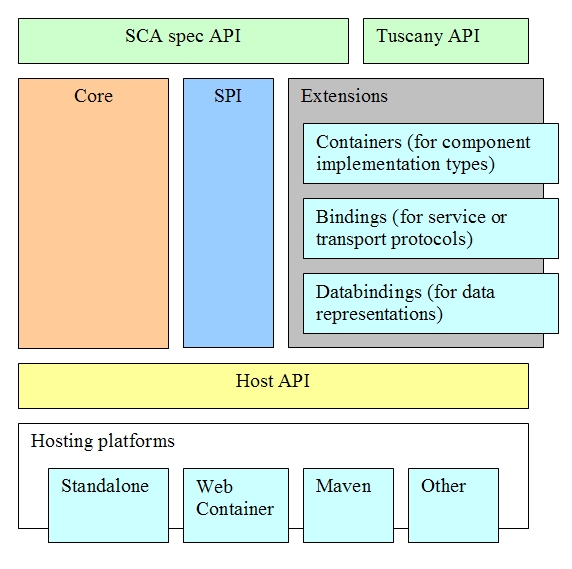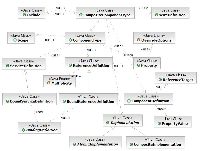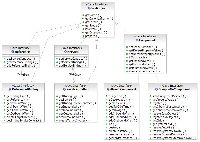This page is work in progress. Thanks for your contribution ![]()
- Kernel overview
- Modules
- Runtime Artifacts
- Recursive Composite
- Wiring
- Bootstrap
- Composite Hierarchy
- Deployment
- Loader
- Builder
- Model
Kernel Overview
This is a high level architecture document for Tuscany Java implementation of Service Component Architecture (SCA) which is defined in the specifications located at (http://wwww.osoa.org![]() ).
).
This is a live document and is more focused on what is implemented rather than the end vision.
Goal of this document is to help users/developers better understand what Tuscany SCA offers and enable them to help with the development if interested.
Tuscany provides the infrastructure for creating, assembling and deploying services in a distributed environment.
At a high level it aims to provide for the following:
- Infrastructure for creating, wiring, deploying and managing service assemblies in single runtime or across runtimes (federated)
- Infrastructure for leveraging qualities of service provided by host environments (transactions, security)
- Support for different host environments: Standalone, Tomcat, J2EE, OSGI (in progress, more can be added)
- plug-points for supporting variety of bindings such as Axis2, RMI, more can be added
- plug-points for adding component implementations such as Java Script, Spring, JRuby, Python (started), more can be added
Module Structure
[Note: Do we want to link to Kernel-Structure![]() ]?
]?
As illustrated below, the Tuscany runtime consists of the following key modules/packages:
- SCA Spec API: The APIs defined by the SCA Java Client and Implementation Spec
- API: Tuscany APIs which extend the SCA spec APIs
- Core: The runtime implementation
- SPI: SPI and base classes to extend the Tuscany runtime. It defines all the contract that Core interacts with Container/Binding/Databinding extensions.
- Extensions:
- Container
- Binding
- Databinding
- Host API: The interface between hosting environments and the Tuscany runtime
- Host Platforms: The environments that host the Tuscany runtime

Runtime Artifacts
- Component
- Basic unit of executable code
- Offer services and have references
- Service
- A contract for component clients consisting of 0..n operations
- Services may be local or remote
- Reference
- A dependency on a service
- Component references are wired to services by the runtime
Recursive Composite
Components may be Atomic or Composite
- Composite components contain 0..n components
Composite services are exposed over 1..n bindings (e.g. SOAP/HTTP, JMS, RMI)
Composite references have 1..n bindings and may target - A service exposed by another composite
- A service outside the SCA system, e.g. "Google search"
A composite may contain just a service wired to a references (mediation) [Haleh: Clarify]
Wiring
To understand how wiring works, we need to detail how Components function in the system. Let's start with Atomic Components and then discuss Composite Components.
Atomic Component
AtomicComponent is the most basic component form. It corresponds to the spec concept which offers services, has references and properties
- Implementation types e.g. Java, XSLT, etc.
- Are wired
- Have properties
Atomic Components have implementation instances. Instances are associated with a scope: e.g. request, conversation, composite. A SCDL entry is used to define a Component. [Haleh: Define scope]
Atomic components use a ScopeContainer to manage implementation instances:
- Composite, HTTP Session, Request, Stateless
- ScopeContainers track implementation instances by scope id and the AtomicComponent instance identity
- Instances are stored in an InstanceWrapper which is specific to the component implementation type (e.g. PojoInstanceWrapper.java)
Component Wiring
Component references are connected to services through wires
- Two sides
- InboundWire - handles the source side of a wire, including policy
- OutboundWire - handles the target side of a wire, including policy
- The runtime connects inbound and outbound wires, performing optimizations if possible
- Inbound and outbound wires may be associated with different service contracts
- Different implementation types
- "Standard" wires contain invocation chains that have Interceptors that perform some form of mediation (e.g. policy)
- Other wire types exist that, for example, do not perform mediations
Invocation Chains
A wire has an InvocationChain per service operation. An InvocationChain may have interceptors - "around-style" mediation. Component implementation instances access a wire through a WireInvocationHandler associated with a reference.
- WireInvocationHandlers may (or may not depending on the component type) be fronted by a proxy
- WireInvocationHandlers dispatch an invocation to the correct chain
A wire has a TargetInvoker that is created from the target side AtomicComponent or Reference and is stored on the source wire invocation handler. The TargetInvoker is resposnible for dispatching the request to the target instance when the message hits the end of the target invocation chain.
Invocation Overview
- An invocation is dispatched to the WireInvocationHandler
- The WireInvocationHandler looks up the correct InvocationChain
- It then creates a message, sets the payload, sets the TargetInvoker, and passes the message down the chain
- When the message reaches the end of the chain, the TargetInvoker is called, which in turn is responsible for dispatching to the target
- Having the TargetInvoker stored on the outbound side allows it to cache the target instance when the wire source has a scope of equal or lesser value than the target (e.g. request-->composite
The runtime provides components with InboundWires and OutboundWires. InvocationChains are held in component wires and are therefore stateless which allows for dynamic behavior such as introduction of new interceptors or re-wiring.
Bootsrap
Bootstrap process is controlled by Host environment. The default process is implemented in DefaultBootstrapper.

Composite Hierarchy
The sequence diagram for the bootstrapping
Deployment
The runtime processes service assemblies serialized using SCA XML vocabulary, SCDL, but can take other forms.
- The load phase processes SCDL and creates an in-memory model
- The build phase evaluates the model and produces corresponding runtime artifacts (e.g. components, services, references)
- The connect phase wires references to services
Loader
SCA service assemblies are deployed to the SCA domain in the format of SCDL files. Tuscany runtime uses loader to load the SCDLs into model objects which are a set of java beans to hold the metadata.
There are two types of loaders:
- StAXElementLoader: Load the XML element from the StAX events
- ComponentTypeLoader: Load the Component Type for an implementation either by introspection or paring a side file
Model
Loading Component Type
Loads the component type definition for a specific implementation
- How it does this is implementation-specific
- May load XML sidefile (location set by implementation)
- May introspect an implementation artifact (e.g. Java annotations)
- ... or anything else
Composite ComponentType Loader
- Load SCDL from supplied URL
- Extract and load SCDL from composite package
POJO ComponentType Loader
- Introspect Java annotations
- Uses a pluggable "annotation processing" framework to introspect Java classes
Builder
Java SCA builder creates a runtime component from the configuration model
- Builder for each implementation type
- Builder for each binding type (service or reference component)
Runtime component manages:
- Implementation instances
- Inbound and Outbound wires
Every implementation is likely to be different
- Different artifacts, programming model, ...
Composite implementation recurses for contained components
- Re-invokes the Builder for every child
Class diagram for the runtime artifacts
Connecting
The connector is reponsible to connect the wires for the components, services and references.
Federated Assembly
<notes from Meeraj's email on 2/1/07 - Haleh included here>
I have been working on the stuff around federated assembly and enabling
distributed SCA domains. Here is a quick summary of what has been done
so far,
Work in progress
Discovery Service
- Provides the low-level communication abstraction for
enabling runtimes participating in the domain to exchange information - The abstraction supports directed message delivery to a
given runtime, asynchronous message reception and broadcast to all
runtimes participating in the domain - To start with we are following a model, where one
runtime in the domain assumes the master role and is responsible for
managing the logical assembly - This runtime creates the physical artifacts and
trensport them to the target slave runtimes - The discovery abstraction is defined in SPI
- There are two implementations in runtime/services - JXTA
and Bonjour - JXTA implementaion is getting pretty much there, it
mainly uses the JXTA Peer Discovery protocol (PDP) and Peer Resolver
Protocol (PRP)
Marshalling Framework
- This is similar to our loader framework, however
supports bi-directional marshalling and unmarshalling of physical model
objects - This framework is used by the assembly service to
serialize and transport physical model information to slave runtimes
using the discovery services - On the receiving end the serialized information is
unmarshalled by the federated deployer for being applied to the slave
runtime - The abstraction is defined in SPI
- I am working on an implementation in core
- The framework supports versioning of physicla model
objects if the participating runtimes are at different versions
Federated Deployer
- This is similar to the local deployer, however registers
itself with the discovery service for receiving physical model updates - The federated deployer doesn't use the loader framework
- The federated deployer accepts serialized physical model
information in XML, rather than raw SCDL as with local deployer - It uses the current builder framework to build, prepare
and start the components
| A note from Jeremy on federated deployment Feb. 9, 2007. The design is that there is a "master" node that is working out which"physical" nodes components are going to run on. It then |
Work outstanding
- Define the physical model in Java
- Define the corresponding XML infoset
Supported Extensions
Spring
1) it allows a Spring application context to act as the
implementation of an SCA component - this allows users to bring
existing Spring applications into an SCA assembly
2) it allows SCA components to act as Spring beans so that users can
use services over SCA from their applications.



